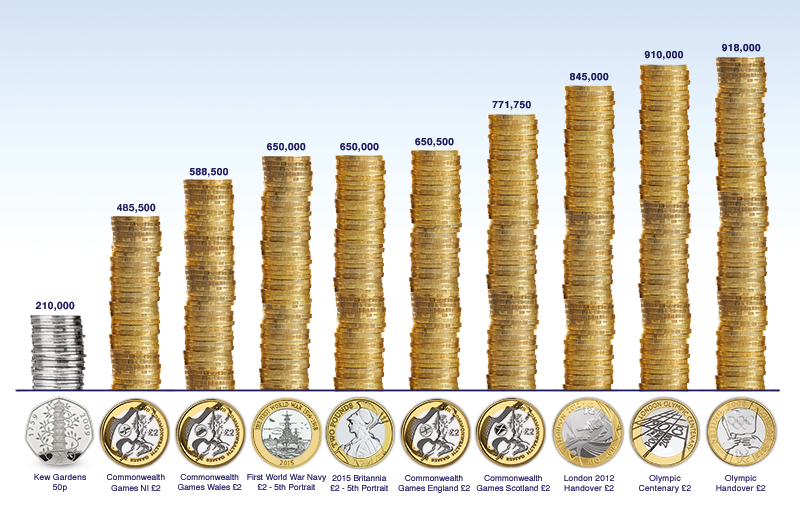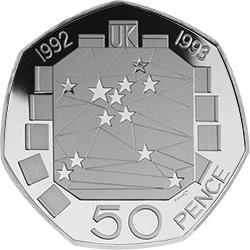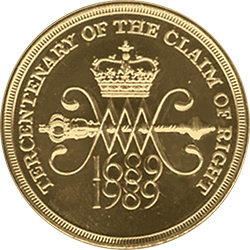Posts Tagged ‘circulation coins’
The UK’s Top 10 Rarest Coins in Circulation
Which coins should you be looking out for in your change?
We’ve taken a look at the mintage figures for UK coins to find out which ones are the rarest in circulation...

What you might be surprised by is that on our top 10 list, just 1 out of the 10 coins is a 50p!
The rarest UK coin currently in circulation is the Kew Gardens 50p, but the 9 rarest coins after that are actually £2s.
Whilst 50p coins are very popular amongst collectors at the moment, it’s certainly worth noting that it is in fact the £2 coins which you should be keeping your eyes peeled for, as some of the ones you can find in your change are very rare.
Other rare coins to look out for
Of course, this doesn’t take into account the rare error coins that have been found in circulation, such as:
- 2015 inverted effigy Britannia £2
- Olympic Aquatics 50p error
- Bronze 20p error
- Silver 2p error
- Undated 20p mule
Whilst exact mintage figures for these error coins may be unknown, we can assume that they could each be rare enough to find themselves near the top of the list.
A-Z of Great Britain 10p coins

It’s also worth noting that whilst mintage figures for the individual designs haven’t been released, if we assume that each A-Z of Great Britain 10p has been struck in equal quantities, then there would be approximately 281,000 of each design.
This would put each A-Z 10p design in equal second place on the list of the top 10 rarest coins in circulation!
What about the coins no longer in circulation?
Currently the Kew Gardens 50p is the rarest coin in circulation, but did you know that it isn’t actually the UK’s rarest 50p?
This title goes to the 1992/93 UK EC Presidency 50p, with a mintage of just 109,000 – almost half of the Kew Gardens!
In 1997, 50p coins were redesigned in the smaller specification and this coin was demonetised, meaning it is no longer in circulation.

The same can be said of the 1989 Claim of Right £2, which was demonetized in 1997 when the bi-metallic £2 coin was introduced.
This coin has a mintage of 381,400 which makes it the rarest UK £2 and would put it in second place on the list if it were still in circulation.

Are you lucky enough to have any of the top 10 rarest coins in your collection? Or perhaps you’ve even been lucky enough to get your hands on the pre-1997 coins listed above. Let us know in the comments below!
If you’re interested in coin collecting, our Change Checker web app is completely free to use and allows users to:
– Find and identify the coins in their pocket
– Collect and track the coins they have
– Swap their spare coins with other Change Checkers

Sign up today at: www.changechecker.org/app
Britain’s top historical coins!
The coins we find in our change can act as a guide to map out our nation’s heritage, and these historical coins play an incredibly important role in preserving these key moments for generations to come.

We put together a list of our top ten historical coins and asked Change Checkers to vote for their all time favourite, read on to find out more about these coins and to find out which was voted your favourite!
10. 2005 Gunpowder Plot £2 – 2% of votes
Theme
In 1605, a failed assassination attempt of King James I by a group of English Catholics went down in history as The Gunpowder Plot. Whilst the 5th of November is now an an exciting celebration with fireworks and bonfires, the plan made by these rebels back in 1605 was far less light hearted…
They plotted to blow up the House of Lords during the opening of Parliament on 5th November 1605, but Guy Fawkes was discovered the night before, guarding 36 barrels of gunpowder and was subsequently executed along with seven other plotters.
Coin Design
In 2005, The Royal Mint issued this £2 coin to mark the 400th anniversary. The reverse design of this coin features a montage of bishop’s crosiers, swords, and the Parliamentary mace – symbolising the survival of the British establishment.
Circulating Mintage – 5,140,500
Scarcity Index Rating – Common
9. 2016 Battle of Hastings 50p – 5% of votes
Theme
In 1066, King Harold II’s English army was defeated by the Norman-French army of William the Conqueror. This led to the Norman conquest of England, with William the Conqueror becoming our first Norman King – a crucial moment in medieval history.
Coin Design
In 2016, The Royal Mint issued this 50p coin to mark the 950th anniversary of this hugely significant event, which changed the course of history. The reverse of this coin was designed by John Bergdahl and is inspired by the Bayeux Tapestry. It depicts the fate of King Harold at the hands of William The Conqueror, along with the famous date 1066. The obverse features the fifth portrait of Queen Elizabeth II by Jody Clark.
Circulating Mintage – 6,700,000
Scarcity Index Rating – Common
8. 2014 First World War Kitchener £2 – 6% of votes
Theme
Horatio Herbert Kitchener, the British Secretary of War, became synonymous with the enlistment campaign when war was declared on 4th August 1914. Intuition told him that the war would last for several years and so he masterminded a recruitment campaign to build the largest volunteer army that Britain had ever seen and oversaw a significant expansion of material production to fight on the Western Front. On 5 June 1916, Kitchener died aboard HMS Hampshire, when it struck a German mine near Scotland and sank.
Coin Design
To mark the centenary of the First World War, the Royal Mint revealed a five-year commemoration of the wartime journey from outbreak to armistice. and the first coin in the series is this £2 bearing a depiction of Lord Kitchener’s famous call to arms alongside the words YOUR COUNTRY NEEDS YOU.
Circulating Mintage – 5,720,000
Scarcity Index Rating – Common
7. 2005 End of World War II £2 – 7% of votes
Theme
The 8th May 1945 is known as VE Day – Victory in Europe, which marked the end of World War Two. This followed Germany’s surrender, about a week after Adolf Hitler had committed suicide during the Battle of Berlin.
Upon Germany’s defeat, an eruption of celebrations swept across the western world and in the UK, more than a million people took to the streets to mark the end of war. In London, King George VI and Queen Elizabeth appeared on the balcony of the palace alongside Prime Minister Winston Churchill, to stand before the cheering crowds.
Coin Design
The reverse design of this £2 features a depiction of St Paul’s Cathedral which survived the Blitz and became a great symbol of hope to a war-torn nation. The edge inscription reads – IN VICTORY: MAGNANIMITY, IN PEACE: GOODWILL – part of the famous maxim that prefaces Churchill’s history of the Second World War.
Circulating Mintage – 10,191,000
Scarcity Index Rating – Common
6. 1998 NHS 50p – 7% of votes
Theme
On the 5th of July 1948, the National Health Service was born – providing a health service available to all and financed entirely from taxation. After a Labour victory in the 1945 general election, Aneurin Bevan became minister of health, responsible for establishing the NHS.
This was the first time that anywhere in the world had completely free healthcare for citizens and brought together hospitals, doctors and nurses as one service, becoming the third largest employer in England.
Coin Design
In 1998, The Royal Mint issued this 50p coin to commemorate the 50th Anniversary of the NHS. The coin’s reverse design features a pair of hands radiating lines to symbolise hope, created by David Cornell. This was the 3rd 50p in the smaller specification ,introduced in 1997, to enter circulation, preceded only by the Britannia 50p and the UK Entry to EEC 50p.
Circulating Mintage – 5,001,000
Scarcity Index Rating – Less Common
5. 2003 Suffragettes 50p – 8% of votes
Theme
With Emmeline and Christabel Pankhurst at its forefront, the Suffragette movement finally saw the partial votes for women in 1918, with the franchise being extended to all women over 21 in 1928. The passionate campaigning for equal voting rights by this pioneering group of women meant that they risked ridicule and even imprisonment in defence of their cause. However, the foundations they laid shaped society’s idea of women and sparked a new era of feminist history.
Coin Design
The Royal Mint issued the Suffragettes 50p in 2003 to commemorate the centenary of the establishment of the Women’s Social and Political Union. The design, by Mary Milner Dickens, features the figure of a suffragette chained to railings holding a banner on which appear the letters WSPU and to the right a ballot paper marked with a cross can be seen.
Circulating Mintage – 3,124,030
Scarcity Index Rating – Less Common
4. 2009 Charles Darwin £2 – 10% of votes
Theme
Charles Darwin has been described as one of the most influential figures in human history and was known as the ‘father or evolution’. Born in 1809, Darwin was a British scientist whose work laid the foundations of the theory of evolution and natural selection, forever transforming the way we think about the natural world.
At the time of publication in 1859, his book ‘On the Origin of the Species’ was extremely controversial as it made it seem possible that humans evolved from apes, contradicting the widely held Orthodox Church theory of creation.
Coin Design
His death on the 19th April 1882 was honoured with a burial at Westminster Abbey and in 2009, The Royal Mint celebrated 200 years since his birth and 150 years since the publication of ‘On the Origin of Species’ with this £2 coin. The reverse design by Suzie Zamit features a profile portrait of Darwin facing a chimpanzee.
Circulating Mintage – 3,903,000
Scarcity Index Rating – Less Common
3. 2015 Magna Carta £2 – 14% of votes
Theme
The Magna Carta or ‘Great Charter’ is known as one of the most famous documents ever written and forms the foundations for modern democracy and the rights of all English citizens today. Issued in 1215 by King John of England (otherwise known as ‘Bad King John’ due to his autocratic rule), the charter made peace with the rebel barons who had been causing a political crisis and stated that everyone (including the king) was subject to the law.
It’s still cited in many legal cases to this day and some of the core values can also be seen in the United States Bill of Rights (1791), despite the document being substantially altered within just 10 years of it being issued.
Coin Design
In 2015, The Royal Mint issued this £2 coin to celebrate the 800th anniversary of the Magna Carta. The reverse design of this medieval-style coin features King John holding a quill and flanked by two noblemen.
Circulating Mintage – 1,495,000
Scarcity Index Rating – Less Common
2. 2016 Great Fire of London £2 – 18% of votes
Theme
The Great Fire is one of the most well-known disasters to hit London, when an accidental spark from a baker’s oven on Pudding Lane led to the destruction of a third of the city. At the time, London had an estimated half a million inhabitants, many of which lived in wooden houses and makeshift structures that had become bone dry during an exceptional drought. Over the course of 4 days, flames reaching temperatures of 1,250 °C consumed 13,200 houses, 87 parish churches, St Paul’s Cathedral, and most of the buildings of the City authorities.
Coin Design
This 2016 £2 coin was issued by The Royal Mint to mark the 350th Anniversary of the poignant moment in the city’s history from which modern London emerged. The reverse depicts the city of London burning in flames from a distance and was designed by Aaron West.
Circulating Mintage – 1,625,000
Scarcity Index Rating – Less Common
1. 2018 Sir Isaac Newton 50p – 23% of votes
The 2018 Sir Isaac Newton 50p was voted a Change Checkers’ all time favourite historical coin!
Theme
Sir Isaac Newton is widely recognised as one of the most influential scientists of all time and a key figure in the scientific revolution. According to the Julian calendar in use in England at the time, Newton was born on Christmas Day, 25 December 1642, in the county of Lincolnshire. He became a fellow of Trinity College and the second Lucasian Professor of Mathematics at the University of Cambridge. His works changed our understanding of mathematics and physics and redefined the way we see the world.
In 1696, on the recommendation of the Chancellor of the Exchequer, Sir Isaac Newton became master of The Royal Mint, where he shaped the security of our currency, ensuring coins were made of the correct weight and fineness, varying as little as possible one from another.
Coin Design
Designed by Aaron West, this 50p coin was issued by The Royal Mint in 2017 to commemorate the achievements of Sir Isaac Newton and remember the legacy he left.
Circulating Mintage – 1,801,500
Scarcity Index Rating – Less Common
I’m sure you’ll agree that each of these historical coins beautifully represent a very special part of British heritage and acts as a window into our past history.
Do you agree with the vote results? If not, let us know in the comments which of these coins is your favourite!
Find out more about your coins

Download the FREE Change Checker Web App to find out more about the coins in your change.
What’s so special about the 2015 Britannia £2 coin?
Britannia has a long standing history with British coinage. Having first appeared on a 1672 Farthing during the reign of Charles II, she subsequently featured on a British coin in one way or another for more than 300 years. In 2008 she was surprisingly dropped from the 50 pence piece despite a Daily Mail campaign to save her.

Britannia has appeared on many British coin denominations over the past 300 years.
After a short absence, in February 2015 it was announced that Britannia would be making a triumphant return to British circulating coins. Antony Dufort’s modern interpretation of Britannia was to feature on Britain’s highest denomination coin, the £2, replacing the “technology” design which had featured on the coin since 1997.

Antony Dufort’s modern interpretation of Britannia.
It was a very popular move from The Royal Mint, even the then Prime Minister David Cameron said: “It is great to see Britannia’s welcome return to our currency. Britannia is an enduring symbol of our national identity, ideal to help reinforce the sense of shared purpose and history for Britons.”
However, it wasn’t until 2016 when The Mint released the mintage figures for the 2015 coins that the real surprise was unveiled.
Only 650,000 of the 2015 date Britannia £2 coins had been stuck for circulation, making it one of the most scarce UK £2 coins ever! So scarce in fact that there were fewer of this coin than the England and the Scotland coins from the famous 2002 Commonwealth Games series.

The 2015 Britannia £2 coin is the joint third most scarce £2 in circulation.
The astonishing fact that Britannia had appeared on a circulating British coin in one way or another in an unbroken cycle between 1672 and 2008 was enough to ensure this £2 would be a favourite with collectors. The announcement of such a low mintage figure then created somewhat of a collecting frenzy!
The 2015 Britannia coin remains highly sought after by collectors.
The UK 2015 Britannia £2 Coin
 This first-year 2015 £2 Britannia is already one of the most-scarce circulating £2 coins ever issued with just 650,000 coins passing through banks and cash centres.
This first-year 2015 £2 Britannia is already one of the most-scarce circulating £2 coins ever issued with just 650,000 coins passing through banks and cash centres.
That places it third equal in the all-time low mintage charts!












